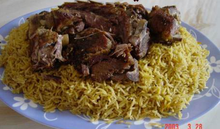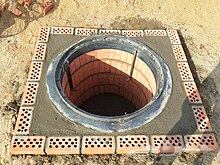Mandi (food)
This article needs additional citations for verification. (June 2016) |
 Homemade mandi from Yemen. | |
| Course | Lunch or dinner |
|---|---|
| Place of origin | Yemen |
| Region or state | Hadhramaut |
| Main ingredients | Rice, meat (lamb or chicken), saffron and a mixture of Hawaij[1] |
 |
| Part of a series on |
| Arab cuisine |
|---|
|


Mandi (Arabic: مندي) is a traditional dish that originated from Hadhramaut, Yemen,[2] consisting mainly of meat and rice with a special blend of spices, cooked in a pit underground. It is extremely popular and prevalent in most areas of the Arabian Peninsula, and even considered a staple dish in many regions. It is also found in Egypt,India, the Levant, and Turkey.
In India Mandi is popular among the Hadhrami people in the Malabar region of Kerala, Bhatkal of Karnataka, as well as Barkas and areas around Hyderabad and Fraser Town and HRBR Layout/Kammanahalli in Bangalore. It is getting more popular in India day by day due to the connection of trade and belonging between the Indian Muslims and the Middle East.
Mandi was usually made from rice, meat (lamb, camel, goat or chicken), and a mixture of spices called hawaij. The meat used is usually a young and small sized lamb to enhance the taste further.
The main technique which differentiates mandi from other meat dishes is that the meat is cooked in the tandoor (taboon in Arabic), which is a special kind of oven which is usually a pit dug up in the ground and covered with clay all around its sides.[3]
Mandi is considered the main dish served during special events, such as Eid, weddings, and feasts in Yemen and southern Saudi Arabia.
Etymology[]
The word "mandi" comes from the Arabic word "nada", meaning "dew", and reflects the moist 'dewy' texture of the meat.[4]
Technique[]
Dry wood (traditionally, Samer or Gadha) is placed in the tandoor and burned to generate a lot of heat turning into charcoal.
The meat is then boiled with whole spices until tender, and the spiced stock is then used to cook the basmati rice at the bottom of the tandoor, then the meat is suspended inside the tandoor above the rice and without touching the charcoal. After that, the whole tandoor is then closed with clay for up to 8 hours.
Raisins, pine nuts, or peanuts can be added to the rice as to one's taste.
See also[]
References[]
- ^ [1][dead link]
- ^ Salloum, Habeeb (2012-02-28). Arabian Nights Cookbook: From Lamb Kebabs to Baba Ghanouj, Delicious Homestyle Arabian Cooking. Tuttle Publishing. ISBN 9781462905249.
- ^ Tracy, Kathleen (2011-03-31). We Visit Saudi Arabia. Mitchell Lane Publishers, Inc. p. 37. ISBN 9781612280851.
mandi saudi arabia.
- ^ "Mandi on my mind". gulfnews.com. Retrieved Jun 5, 2021.
External links[]
- Yemeni cuisine
- Emirati cuisine
- Palestinian cuisine
- Rice dishes
- Arab cuisine
- Arab cuisine stubs